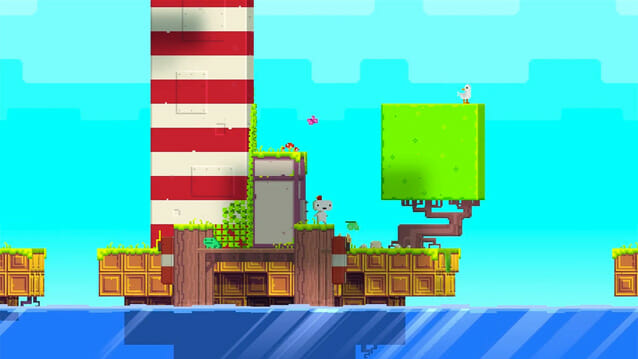Fez (XBLA)

In videogames, we have to interact with surfaces, and use trial and error to construct a mental model of what lies below—how high we can jump, how far we can fall. The game knows this information to an exact degree. We can only approximate. This is part of the challenge of the platformer: first you figure out where you can go, then you go there.
The main goal of Fez is to navigate Gomez, your avatar, through the game’s space. Successful navigation rewards you with 32 golden cubes (many of which are broken up into eight smaller cubes). Once you’ve collected enough, doors open in the world that give you access to more spaces to traverse.
What makes a game like Fez a puzzle platformer is the addition of some extra mechanic: manipulation of time or space, usually, or any extra way to interact with the environment, to mess with it until the usual jumping and falling can get you to where you need to be. With Fez, it’s the apparently-three-dimensional rotation of 2D spaces.
Pull the triggers or press the shoulder buttons and the objects on the screen rotate 90 degrees. This rotation happens on a smaller scale: open Gomez’s inventory and move between its sections the same way. Examine an item (an artifact or treasure map, clues to hidden “anticubes”, of which there are also 32, and which also count toward opening the doors) and you can look at its four sides as well.
Environmental manipulation is a tricky thing. It feels like it puts the player closer to the designer (after all, you’re not just reacting to the world, you’re actively changing it), but at the same time you’re still bound by the rules. They’re just a little more lenient on what you can do to things beyond your avatar.
Surfaces are the most important part of a platformer, the barrier between safety and danger, life and death. When you rotate nearly every screen in Fez, you change the relationship between the surfaces of platforms. Navigation becomes a matter of lining things up: move two platforms close enough so you can jump from one to the other, spin the world so climbable ivy stretches around a corner.
Death is no big deal—fall too far and a split-second later you’re back where you last stood on solid ground. Sometimes I’d react to a mistake by causing Gomez to fall to his death, intentionally avoiding a safe landing, this larger failure ultimately saving me time and effort as I wouldn’t have to climb back to where I originally fell.
The “well-designed” puzzle platformer is, I expect, one where every action is foreshadowed, where complexity increases as you move through the game not through the addition of new rules but through the “natural” applications of the original ones.
And so puzzle platformers like Fez require not just the manual dexterity to navigate their space, but the mental dexterity to figure out how to manipulate it. But they’re bounded spaces and the possibilities are not limitless. So the most efficient way to navigate them is to figure out how they were designed to be navigated. We have to get inside someone’s head.

Maybe it’s because of this that the strong presence of an abstract Designer is so prevalent in this kind of game (see Portal for its most explicit example). And that abstract Designer makes this kind of game just ripe for the auteur reading (see Braid and Jonathan Blow for an approach to production that encourages an auteur reading).